Shoulder Muscle Strength and Neuromuscular Activation 2 Years after Reverse Shoulder Prosthesis—An Experimental Case Control Study
Abstract
:1. Introduction
2. Materials and Methods
2.1. Subjects
2.2. Range of Motion and Clinical Outcome Scores
2.3. Radiographic Evaluation
2.4. Assessment of Muscle Strength
- -
- for abduction and adduction: starting position at 30° of abduction, neutral elbow position, neutral hand position, handle parallel to the chair;
- -
- for flexion and extension: starting position at 30° of abduction, neutral elbow position, hand in 30° pronation;
- -
- for internal and external rotation: starting position at 90° of abduction, elbow at 90° of flexion, hand in neutral position.
2.5. Assessment of EMG Activity
2.6. Statistics
3. Results
4. Discussion
5. Conclusions
Author Contributions
Conflicts of Interest
References
- Grammont, P.M.; Baulot, E. Delta shoulder prosthesis for rotator cuff rupture. Orthopedics 1993, 16, 65–68. [Google Scholar] [CrossRef] [PubMed]
- Boileau, P.; Watkinson, D.J.; Hatzidakis, A.M.; Balg, F. Grammont reverse prosthesis: Design, rationale, and biomechanics. J. Shoulder Elbow Surg. 2005, 14, 147S–161S. [Google Scholar] [CrossRef] [PubMed]
- Jobin, C.M.; Brown, G.D.; Bahu, M.J.; Gardner, T.R.; Bigliani, L.U.; Levine, W.N.; Ahmad, C.S. Reverse total shoulder arthroplasty for cuff tear arthropathy: the clinical effect of deltoid lengthening and center of rotation medialization. J. Shoulder Elbow Surg. 2012, 21, 1269–1277. [Google Scholar] [CrossRef] [PubMed]
- Cuff, D.; Clark, R.; Pupello, D.; Frankle, M. Reverse shoulder arthroplasty for the treatment of rotator cuff deficiency: A concise follow-up, at a minimum of five years, of a previous report. J. Bone Joint Surg. Am. 2012, 94, 1996–2000. [Google Scholar] [CrossRef]
- Greiner, SH.; Back, D.A.; Herrmann, S.; Perka, C.; Asbach, P. Degenerative changes of the deltoid muscle have impact on clinical outcome after reversed total shoulder arthroplasty. Arch. Orthop. Trauma Surg. 2010, 130, 177–183. [Google Scholar] [CrossRef]
- Favard, L.; Levigne, C.; Nerot, C.; Gerber, C.; De Wilde, L.; Mole, D. Reverse prostheses in arthropathies with cuff tear are survivorship and function maintained over time? Clin. Orthop. Relat. Res. 2011, 469, 2469–2475. [Google Scholar] [CrossRef] [Green Version]
- Smith&nephew. Surgical Technique Promos Reverse Modular Shoulder System. Available online: http://www.smith-nephew.com/global/assets/pdf/products/surgical/promos_reverse_st.pdf (accessed on 25 November 2019).
- Edwards, T.B.; Morris, J.B. Reverse shoulder arthroplasty. Shoulder Arthroplasty, 2nd ed.; Elsevier: Philadelphia, PA, USA, 2019; pp. 147–159. [Google Scholar]
- Constant, C.R.; Murley, A.G. A clinical method of functional assessment of the shoulder. Clin. Orthop. Relat. Res. 1987, 214, 160–164. [Google Scholar] [CrossRef]
- Beaton, D.E.; Wright, J.G.; Katz, J.N.; Group, U.E.C. Development of the QuickDASH: comparison of three item-reduction approaches. J. Bone Joint Surg. Am. 2005, 87, 1038–1046. [Google Scholar]
- Lädermann, A.; Williams, M.D.; Melis, B.; Hoffmeyer, P.; Walch, G. Objective evaluation of lengthening in reverse shoulder arthroplasty. J. Shoulder Elbow Surg. 2009, 18, 588–595. [Google Scholar] [CrossRef]
- Koo, T.K.; Li, M.Y. A guideline of selecting and reporting intraclass correlation coefficients for reliability research. J. Chiropr. Med. 2016, 15, 155–163. [Google Scholar] [CrossRef] [Green Version]
- Boettcher, C.E.; Ginn, K.A.; Cathers, I. Standard maximum isometric voluntary contraction tests for normalizing shoulder muscle EMG. J. Orthop. Res. 2008, 26, 1591–1597. [Google Scholar] [CrossRef] [PubMed]
- Miller, R.G.; Giannini, D.; Milner-Brown, H.S.; Layzer, R.B.; Koretsky, A.P.; Hooper, D.; Weiner, M.W. Effects of fatiguing exercise on high-energy phosphates, force, and EMG: Evidence for three phases of recovery. Muscle Nerve 1987, 10, 810–821. [Google Scholar] [CrossRef] [PubMed]
- Hopkins, W.G. Measures of reliability in sports medicine and science. Sport Med. 2000, 30, 1–15. [Google Scholar] [CrossRef] [PubMed] [Green Version]
- Ackland, D.C.; Roshan-Zamir, S.; Richardson, M.; Pandy, M.G. Muscle and joint-contact loading at the glenohumeral joint after reverse total shoulder arthroplasty. J. Orthop. Res. 2011, 29, 1850–1858. [Google Scholar] [CrossRef]
- Walker, D.; Wright, T.W.; Banks, S.A.; Struk, A.M. Electromyographic analysis of reverse total shoulder arthroplasties. J. Shoulder Elbow Surg. 2014, 23, 166–172. [Google Scholar] [CrossRef] [PubMed]
- Pegreffi, F.; Pellegrini, A.; Paladini, P.; Merolla, G.; Belli, G.; Velarde, P.U.; Porcellini, G. Deltoid muscle activity in patients with reverse shoulder prosthesis at 2-year follow-up. Musculoskelet Surg. 2017, 101, 129–135. [Google Scholar] [CrossRef]
- Li, H.; Yoon, S.H.; Lee, D.; Chung, H. Relation between preoperative electromyographic activity of the deltoid and upper trapezius muscle and clinical results in patients treated with reverse shoulder arthroplasty. J. Shoulder Elbow Surg. 2020, 29, 195–201. [Google Scholar] [CrossRef] [Green Version]
- Hoenecke, H.R.; Flores-Hernandez, C.; D’Lima, D.D. Reverse total shoulder arthroplasty component center of rotation affects muscle function. J. Shoulder Elbow Surg. 2014, 23, 1128–1135. [Google Scholar] [CrossRef]
- Berliner, J.L.; Regalado-Magdos, A.; Ma, C.B.; Feeley, B.T. Biomechanics of reverse total shoulder arthroplasty. J. Shoulder Elbow Surg. 2015, 24, 150–160. [Google Scholar] [CrossRef]
- Kontaxis, A.; Johnson, G.R. The biomechanics of reverse anatomy shoulder replacement—A modelling study. Clin. Biomech. 2009, 24, 254–260. [Google Scholar] [CrossRef]
- Herrmann, S.; König, C.; Heller, M.; Perka, C.; Greiner, S. Reverse shoulder arthroplasty leads to significant biomechanical changes in the remaining rotator cuff. J. Orthop. Surg. Res. 2011, 6, 1–7. [Google Scholar] [CrossRef] [PubMed] [Green Version]
- Valenti, P.; Sauzières, P.; Katz, D.; Kalouche, I.; Kilinc, A.S. Do less medialized reverse shoulder prostheses increase motion and reduce notching? Clin. Orthop. Relat. Res. 2011, 469, 2550–2557. [Google Scholar] [CrossRef] [PubMed] [Green Version]
- Walker, M.; Brooks, J.; Willis, M.; Frankle, M. How reverse shoulder arthroplasty works. Clin. Orthop. Relat. Res. 2011, 469, 2440–2451. [Google Scholar] [CrossRef] [Green Version]
- Ackland, D.; Richardson, M.; Pandy, M. Axial rotation moment arms of the shoulder musculature after reverse total shoulder arthroplasty. J. Bone Joint Surg. Am. 2012, 94, 1886–1895. [Google Scholar] [CrossRef]
- Ackland, D.C.; Robinson, D.L.; Wilkosz, A.; Wu, W.; Richardson, M.; Lee, P.; Tse, K.M. The influence of rotator cuff tears on muscle and joint-contact loading after reverse total shoulder arthroplasty. J. Orthop. Res. 2019, 37, 211–219. [Google Scholar] [CrossRef] [Green Version]
- Lädermann, A.; Edwards, T.B.; Walch, G. Arm lengthening after reverse shoulder arthroplasty: A review. Int. Orthop. 2014, 38, 991–1000. [Google Scholar] [CrossRef] [Green Version]
- Ladermann, A.; Lubbeke, A.; Melis, B.; Stern, R.; Christofilopoulos, P.; Bacle, G.; Walch, G. Prevalence of neurologic lesions after total shoulder arthroplasty. J. Bone Joint Surg. Am. 2011, 93, 1288–1293. [Google Scholar] [CrossRef]
- Scalise, J.; Jaczynski, A.; Jacofsky, M. The effect of glenosphere diameter and eccentricity on deltoid power in reverse shoulder arthroplasty. Bone Joint J. 2016, 98, 218–223. [Google Scholar] [CrossRef]
- Chou, J.; Malak, S.F.; Anderson, I.A.; Astley, T.; Poon, P.C. Biomechanical evaluation of different designs of glenospheres in the SMR reverse total shoulder prosthesis: Range of motion and risk of scapular notching. J. Shoulder Elbow Surg. 2009, 18, 354–359. [Google Scholar] [CrossRef]
- Harman, M.; Frankle, M.; Vasey, M.; Banks, S. Initial glenoid component fixation in “reverse” total shoulder arthroplasty: a biomechanical evaluation. J. Shoulder Elbow Surg. 2005, 14, 162S–167S. [Google Scholar] [CrossRef]
- Alta, T.D.W.; Veeger, H.E.J.; Janssen, T.W.J.; Willems, W.J. Are shoulders with a reverse shoulder prosthesis strong enough? A pilot study. Clin. Orthop. Relat. Res. 2012, 470, 2185–2192. [Google Scholar] [CrossRef] [PubMed] [Green Version]
- Hawkes, D.H.; Alizadehkhaiyat, O.; Fisher, A.C.; Kemp, G.J.; Roebuck, M.M.; Frostick, S.P. Normal shoulder muscular activation and co-ordination during a shoulder elevation task based on activities of daily living: an electromyographic study. J. Orthop. Res. 2012, 30, 53–60. [Google Scholar] [CrossRef] [PubMed]
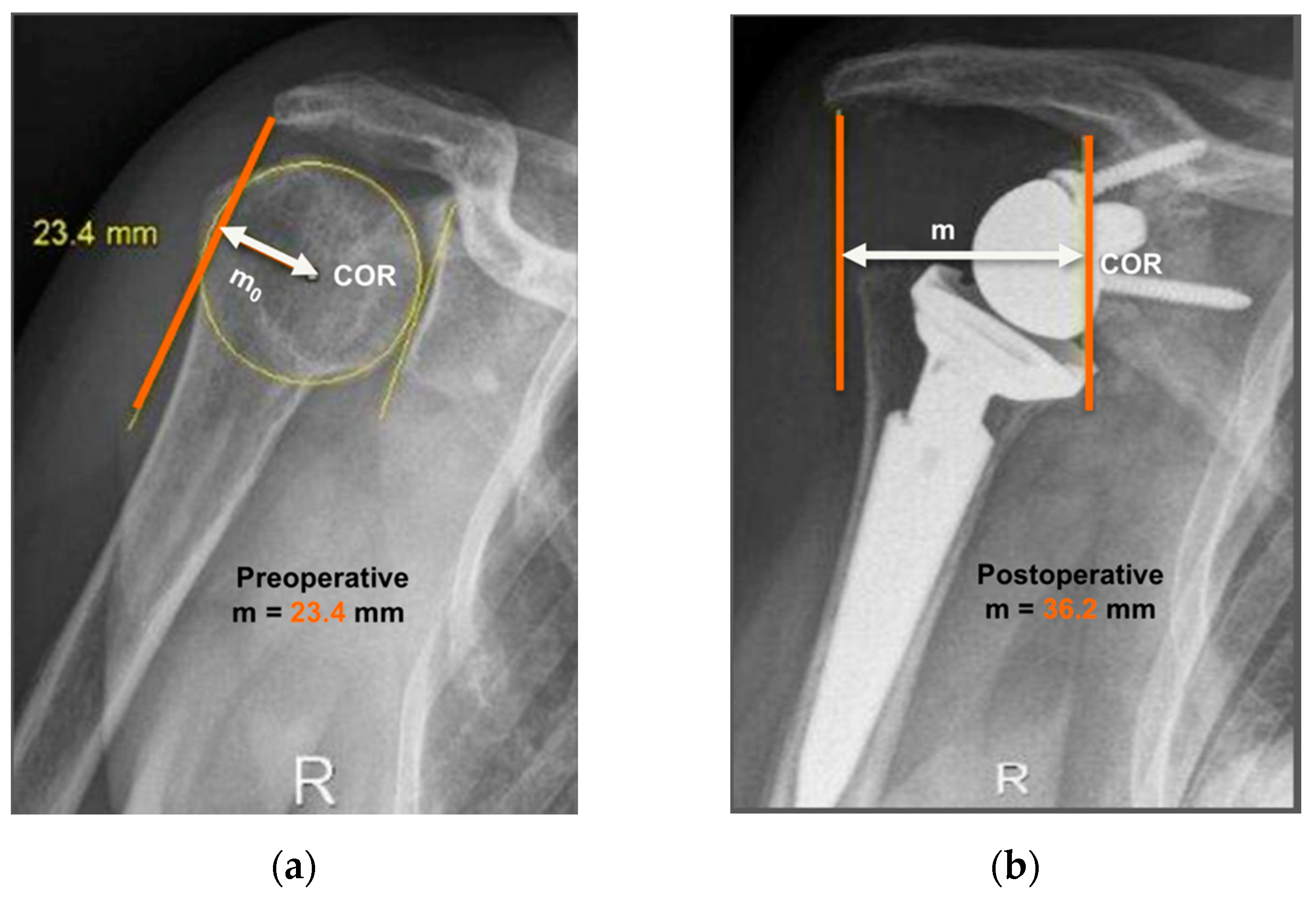
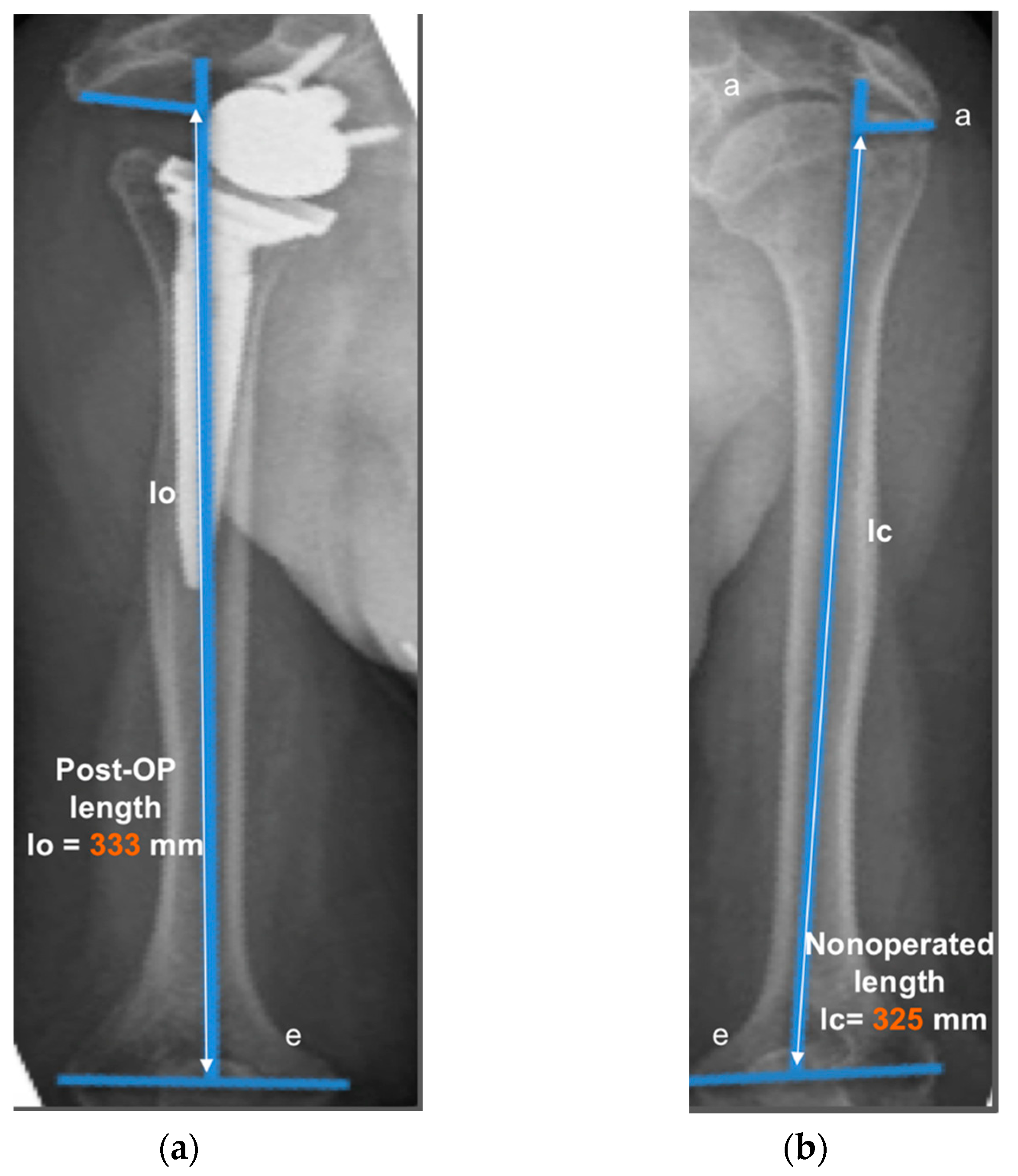
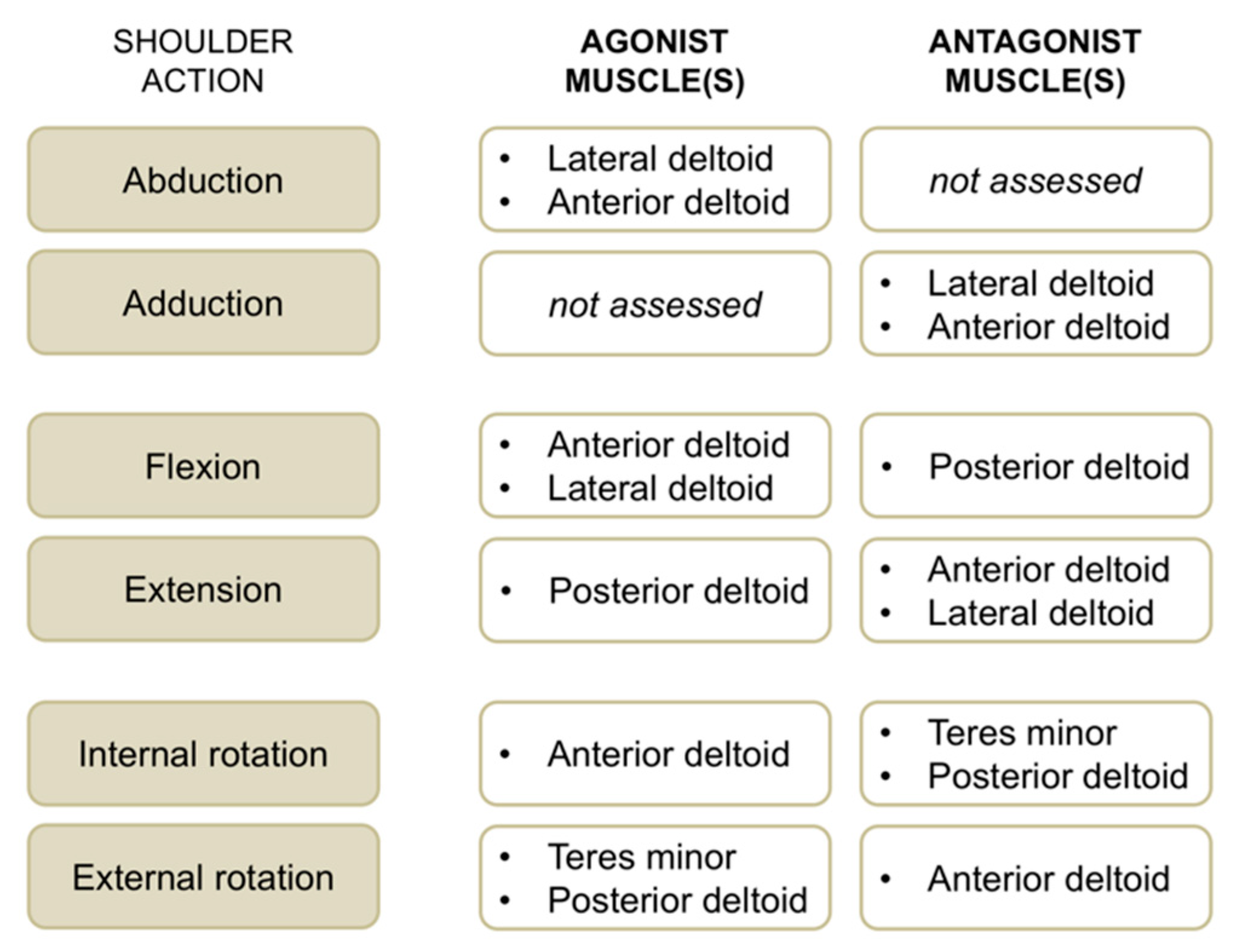
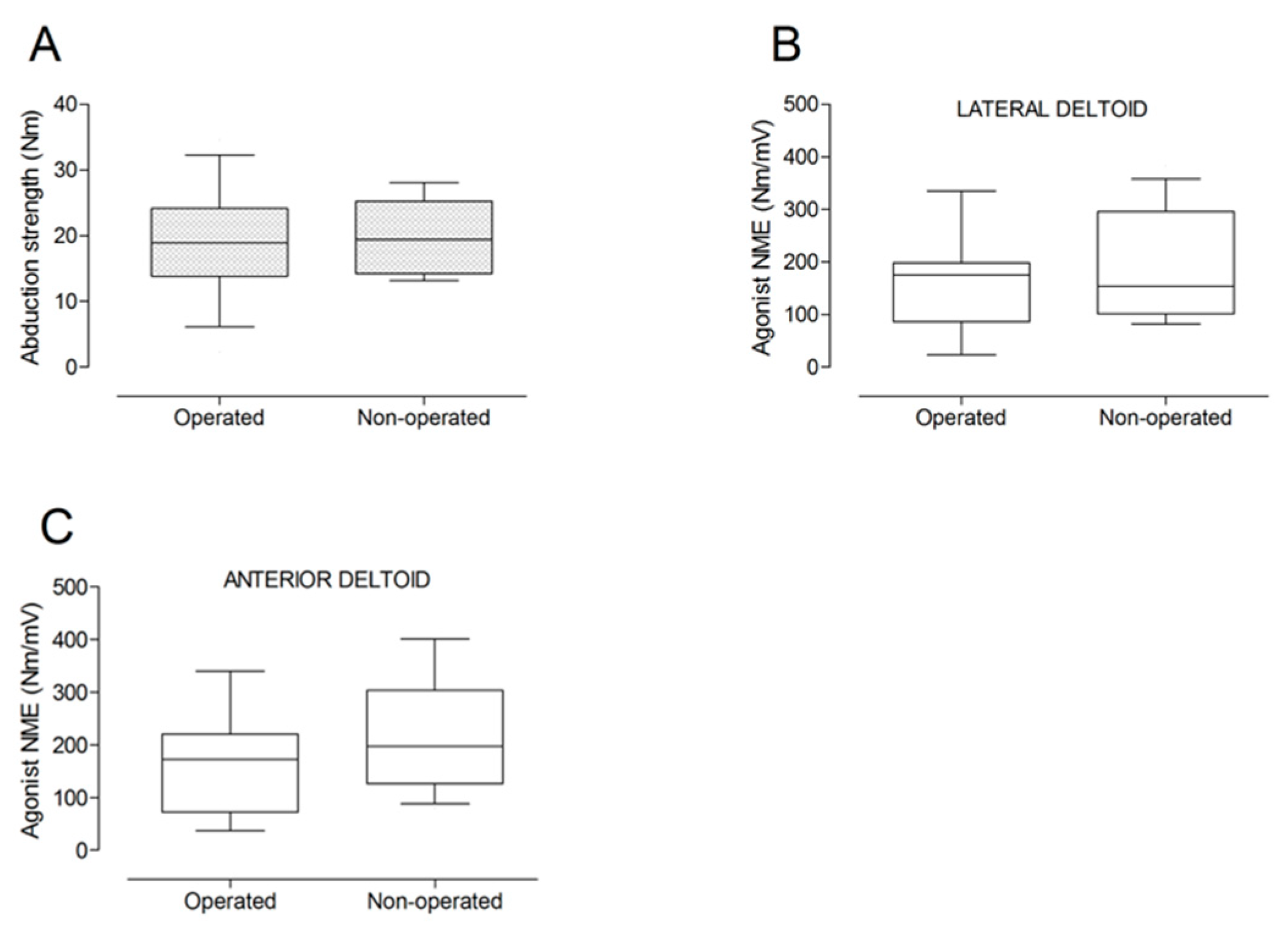
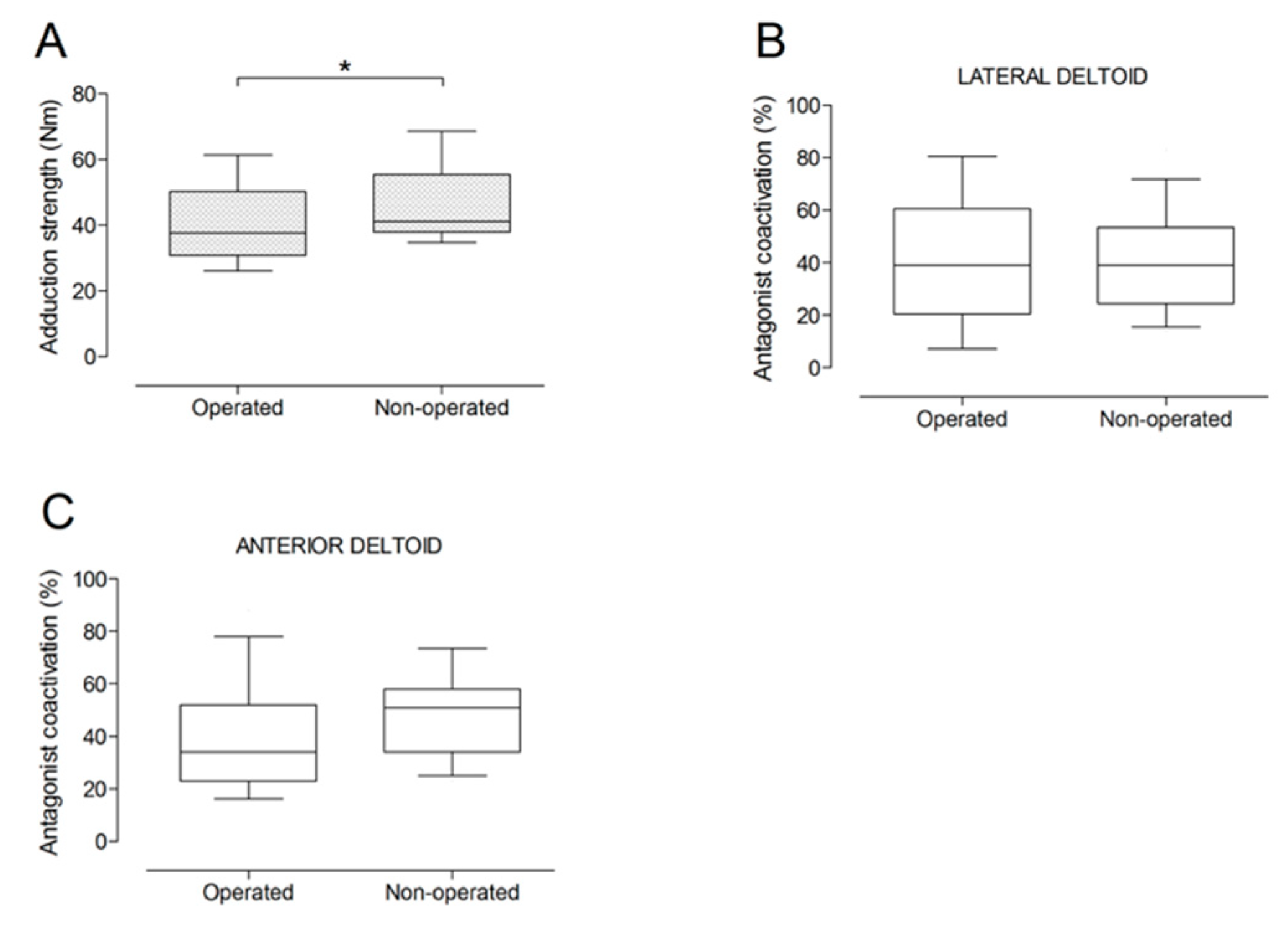



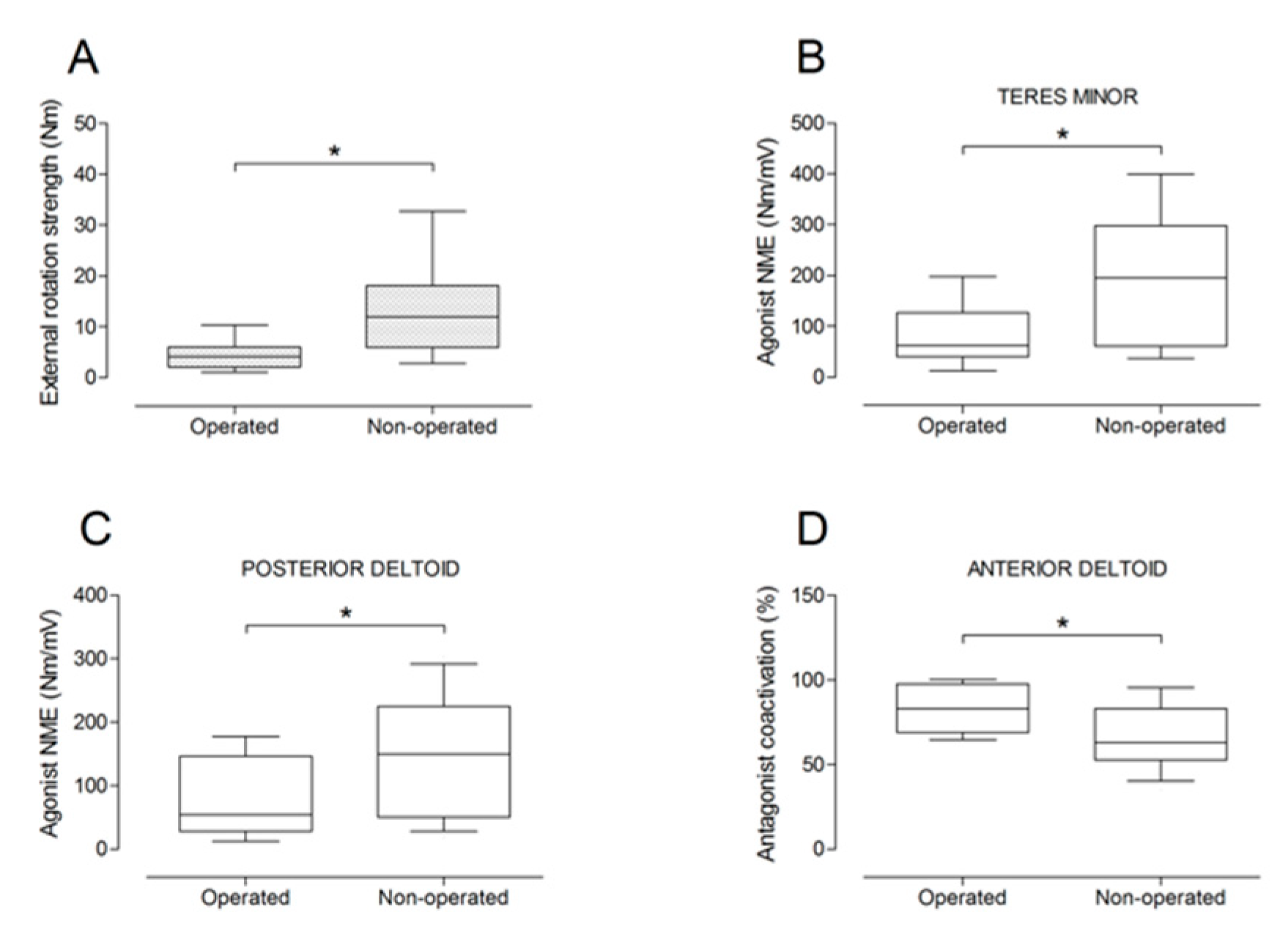
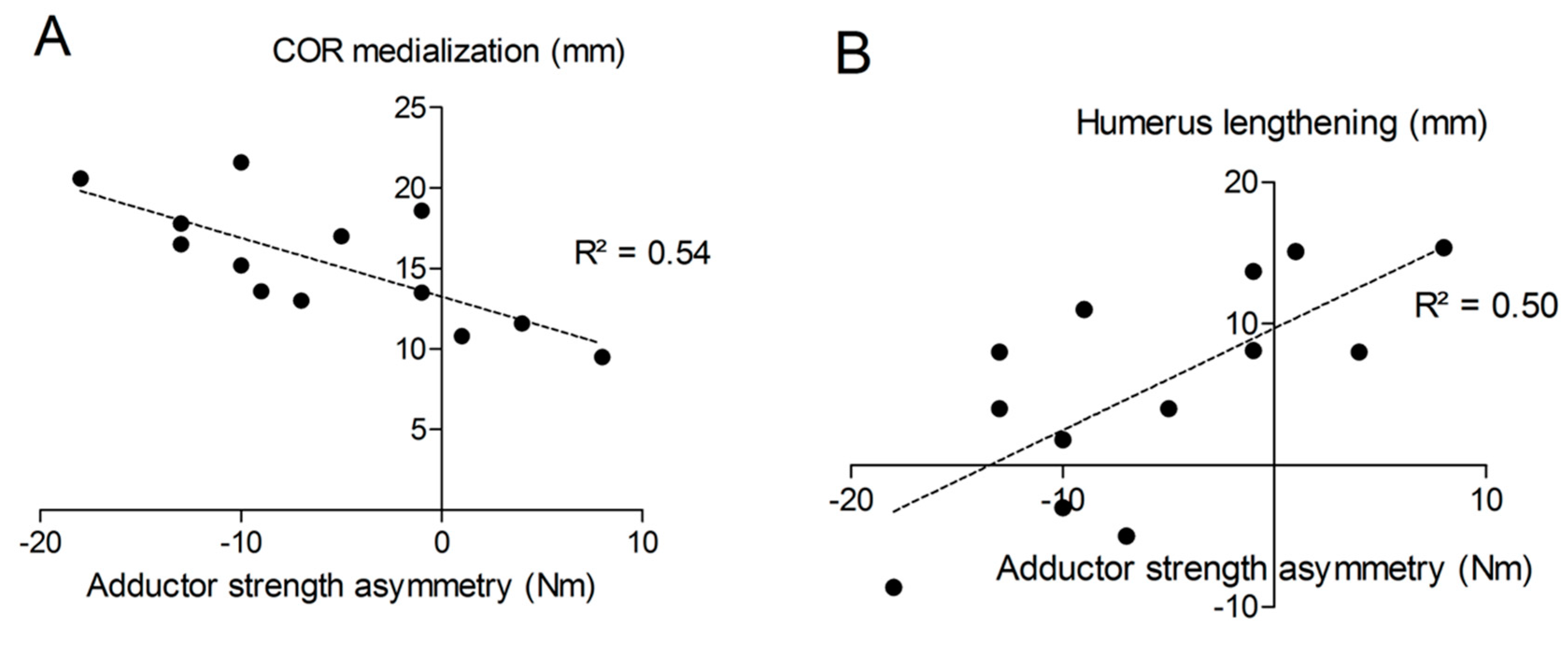
| Variable | Mean ± SD (range) | |
|---|---|---|
| N | 13 (7 women) | |
| Age (yrs) | 73 ± 12 (48–87) | |
| Body mass index (kg/m2) | 28 ± 4 (18–35) | |
| Postoperative follow-up (months) | 24 ± 1 (23–26) | |
| Operated side | 11 right (8 dominant) | |
| Clinical outcome scores | Pre-operative | Post-operative |
| Constant score (0–100) | 39 ± 11 (21–59) | 76 ± 9 (50–84) * |
| QuickDASH score (0–100) | 48 ± 17 (29–90) | 82 ± 16 (50–97) * |
| Active range of motion | Operated side | Non-operated side |
| Abduction (°) | 130 ± 18 (100–160) | 160 ± 11 (140–170) * |
| Flexion (°) | 140 ± 7 (120–145) | 170 ± 11 (150–180) * |
| Internal rotation (°) | 30 ± 13 (20–60) | 50 ± 7 (40–60) * |
| External rotation (°) | 60 ± 13 (40–80) | 80 ± 10 (60–90) * |
© 2020 by the authors. Licensee MDPI, Basel, Switzerland. This article is an open access article distributed under the terms and conditions of the Creative Commons Attribution (CC BY) license (http://creativecommons.org/licenses/by/4.0/).
Share and Cite
Rienmüller, A.; Maffiuletti, N.A.; Schwyzer, H.-K.; Eggspühler, A. Shoulder Muscle Strength and Neuromuscular Activation 2 Years after Reverse Shoulder Prosthesis—An Experimental Case Control Study. J. Clin. Med. 2020, 9, 365. https://doi.org/10.3390/jcm9020365
Rienmüller A, Maffiuletti NA, Schwyzer H-K, Eggspühler A. Shoulder Muscle Strength and Neuromuscular Activation 2 Years after Reverse Shoulder Prosthesis—An Experimental Case Control Study. Journal of Clinical Medicine. 2020; 9(2):365. https://doi.org/10.3390/jcm9020365
Chicago/Turabian StyleRienmüller, Anna, Nicola A. Maffiuletti, Hans-Kaspar Schwyzer, and Andreas Eggspühler. 2020. "Shoulder Muscle Strength and Neuromuscular Activation 2 Years after Reverse Shoulder Prosthesis—An Experimental Case Control Study" Journal of Clinical Medicine 9, no. 2: 365. https://doi.org/10.3390/jcm9020365
APA StyleRienmüller, A., Maffiuletti, N. A., Schwyzer, H.-K., & Eggspühler, A. (2020). Shoulder Muscle Strength and Neuromuscular Activation 2 Years after Reverse Shoulder Prosthesis—An Experimental Case Control Study. Journal of Clinical Medicine, 9(2), 365. https://doi.org/10.3390/jcm9020365





